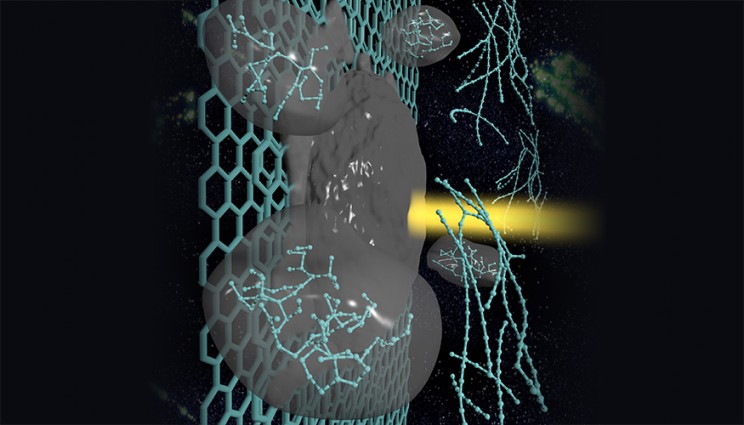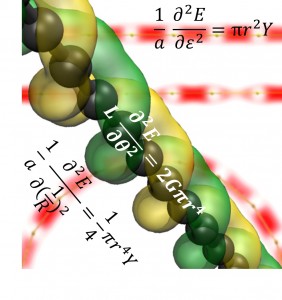An international group of researchers has developed a technique for producing a record-breaking length of one-dimensional carbon (carbon chain) according to an April 4, 2016 news item on Nanowerk,
Elemental carbon appears in many different modifications, including diamond, fullerenes and graphene. Their unique structural, electronic, mechanical, transport and optical properties have a broad range of applications in physics, chemistry and materials science, including composite materials, nanoscale light emitting devices and energy harvesting materials. Within the “carbon family”, only carbyne, the truly one-dimensional form of carbon, has not yet been synthesized despite having been studied for more than 50 years. Its extreme instability in ambient conditions rendered the final experimental proof of its existence elusive.
An international collaboration of researchers now succeeded in developing a novel route for the bulk production of carbon chains composed of more than 6,400 carbon atoms by using thin double-walled carbon nanotubes as protective hosts for the chains.
An April 4, 2016 University of Vienna press release (also on EurekAlert) provides another perspective on the research,
Even in its elemental form, the high bond versatility of carbon allows for many different well-known materials, including diamond and graphite. A single layer of graphite, termed graphene, can then be rolled or folded into carbon nanotubes or fullerenes, respectively. To date, Nobel prizes have been awarded for both graphene (2010) and fullerenes (1996). Although the existence of carbyne, an infinitely long carbon chain, was proposed in 1885 by Adolf von Baeyer (Nobel laureate for his overall contributions in organic chemistry, 1905), scientists have not yet been able to synthesize this material. Von Baeyer even suggested that carbyne would remain elusive as its high reactivity would always lead to its immediate destruction. Nevertheless, carbon chains of increasing length have been successfully synthesized over the last 50 years, with a record of around 100 carbon atoms (2003). This record has now been broken by more than one order of magnitude, with the demonstration of micrometer length-scale chains.
The new record
Researchers from the University of Vienna, led by Thomas Pichler, have presented a novel approach to grow and stabilize carbon chains with a record length of 6,000 carbon atoms, improving the previous record by more than one order of magnitude. They use the confined space inside a double-walled carbon nanotube as a nano-reactor to grow ultra-long carbon chains on a bulk scale. In collaboration with the groups of Kazu Suenaga at the AIST Tsukuba [National Institute of Advanced Industrial Science and Technology] in Japan, Lukas Novotny at the ETH Zürich [Swiss Federal Institute of Technology] in Switzerland and Angel Rubio at the MPI [Max Planck Institute] Hamburg in Germany and UPV/EHU [University of the Basque Country] San Sebastian in Spain, the existence of the chains has been unambiguously confirmed by using a multitude of sophisticated, complementary methods. These are temperature dependent near- and far-field Raman spectroscopy with different lasers (for the investigation of electronic and vibrational properties), high resolution transmission electron spectroscopy (for the direct observation of carbyne inside the carbon nanotubes) and x-ray scattering (for the confirmation of bulk chain growth).
The researchers present their study in the latest edition of Nature Materials. “The direct experimental proof of confined ultra-long linear carbon chains, which are more than an order of magnitude longer than the longest proven chains so far, can be seen as a promising step towards the final goal of unraveling the “holy grail” of carbon allotropes, carbyne”, explains the lead author, Lei Shi.
Application potential
Carbyne is very stable inside double-walled carbon nanotubes. This property is crucial for its eventual application in future materials and devices. According to theoretical models, carbyne’s mechanical properties exceed all known materials, outperforming both graphene and diamond. Carbyne’s electrical properties suggest novel nanoelectronic applications in quantum spin transport and magnetic semiconductors.
Here’s a link to and a citation for the paper,
Confined linear carbon chains as a route to bulk carbyne by Lei Shi, Philip Rohringer, Kazu Suenaga, Yoshiko Niimi, Jani Kotakoski, Jannik C. Meyer, Herwig Peterlik, Marius Wanko, Seymur Cahangirov, Angel Rubio, Zachary J. Lapin, Lukas Novotny, Paola Ayala, & Thomas Pichler. Nature Materials (2016) doi:10.1038/nmat4617 Published online 04 April 2016
This paper is behind a paywall.
But, there is this earlier and open access version on arXiv.org,
Confined linear carbon chains: A route to bulk carbyne
Lei Shi, Philip Rohringer, Kazu Suenaga, Yoshiko Niimi, Jani Kotakoski, Jannik C. Meyer, Herwig Peterlik, Paola Ayala, Thomas Pichler (Submitted on 17 Jul 2015 (v1), last revised 20 Jul 2015 (this version, v2))

![[downloaded from http://pubs.acs.org/doi/abs/10.1021/nl5017317]](http://www.frogheart.ca/wp-content/uploads/2014/07/CarbyneMorphs-300x166.gif)
